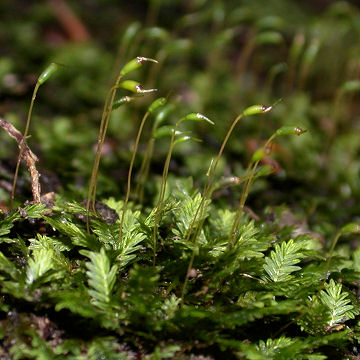

Fissidens taxifolius - (image 1 of 4)
Taxonomy
Family: Fissidentaceae
Habitat
On calcareous soil or rocks in shaded habitats.
Associates
Distribution
New England west to SD, south to FL and TX. Also found in Canada, Europe, and eastern Asia.
Morphology
Autoicous moss to 8 mm high. Leaves 1.5 to 2.2 mm long, evenly crenate-serrulate; costa brownish, ending near a cuspidate apiculus. Setae borne laterally, to 11 mm long, reddish; capsule 1.2 to 1.5 mm long, inclined, constricted below the operculum.
Notes
Terrestrial members of this genus typically form somewhat large colonies of flattened, feathery shoots. The leaves are borne in two ranks and have vaginate laminae that clasp the stem and the base of the leaf above it.
The costa of F. bushii is similar in color to the leaf, not darker or brownish as in F. taxifolius, and has a less distinct apiculus. It is also dioicous.
The specific epithet (taxifolius) likely alludes to the similarity to yew (Taxus spp.).
Bibliography
Crum, H. 2004. Mosses of the Great Lakes Forest, 4th ed.
The University of Michigan Herbarium. Ann Arbor, MI
USDA, NRCS. 2002. The PLANTS Database, Version 3.5 (http://plants.usda.gov).
National Plant Data Center, Baton Rouge, LA 70874-4490 USA.
|
Michael Hough © 2009 |